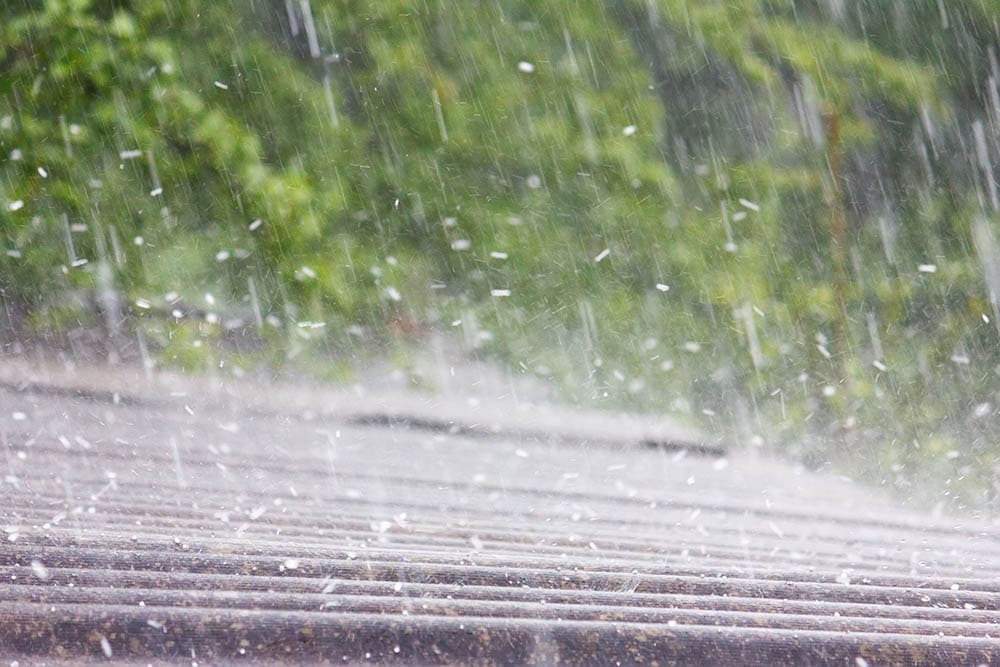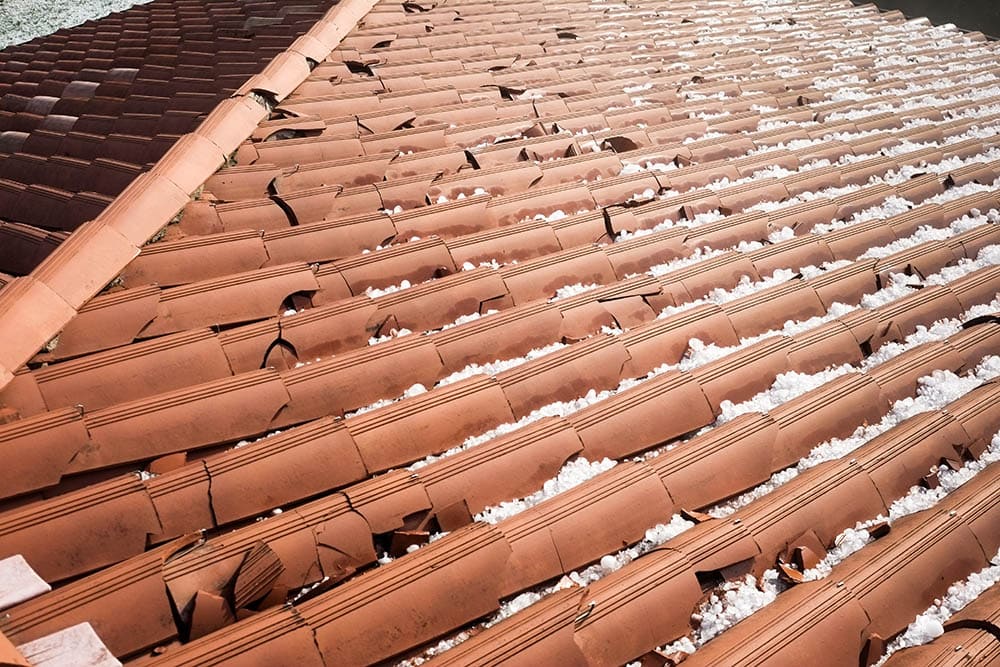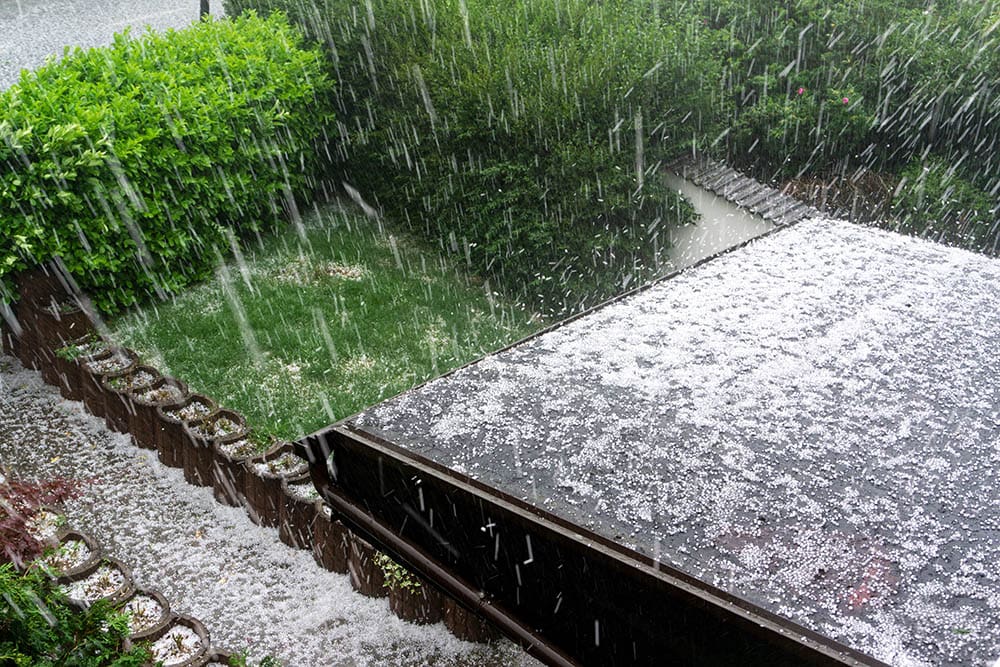What Does Hail Damage Appear Like on a Roof? Signs, Types & FAQs
-
Caroline Bonin
- Last updated:

6.2 million properties in the United States were damaged by hail events in 2020, with almost $14.2 billion in losses. While it’s known for wreaking havoc on cars, hail can cause lasting damage to the roof of your house, too.
It’s crucial to learn the signs of hail damage in order to make any necessary repairs. If Left untreated, such damage can shorten the lifespan of your roof and even contribute to the need for a costly replacement.
If you don’t know what hail damage looks like, you’re not alone. Depending on the size of the hail, you may see dents, dings, or bruises on your shingles where the pieces of hail struck. Its subtlety can make it difficult to spot, especially from the ground. In this article, we’ll give you everything you need to diagnose and treat potential hail damage on your roof.
How To Tell if Your Roof Has Hail Damage
If the hail is large enough, the damage to your roof may be immediately apparent. You may see dents, dings, or bruises on your shingles where the pieces of hail struck.
Even if you don’t see those, it doesn’t mean your roof hasn’t been damaged. There are other ways to tell if the recent hail you experienced left a mark. The easiest method is to inspect your gutters and downspouts. They will show the dents more readily, which indicates that your roof may have taken some hits as well. And if hail knocks granules off of your shingles, those granules may collect in the gutter and cause a clog.
Not everyone feels comfortable climbing on their roof to check for damage, and the good news is that you don’t have to.
- Dings on your siding or garage door
- Holes in your window screens
- Dents on your mailbox, car, or other soft metals on your property
- Marks on your shutters or deck
If you’re suspicious that your roof has been damaged by hail, but you aren’t totally certain, you can hire a technician to inspect your roof for you.

What Size Hail Will Damage a Roof?
Typically, ½-inch hail and smaller pieces won’t cause lasting damage to your roof unless your roof is old or vulnerable. When the diameter falls between ¾-inch and 1-inch, also known as dime and quarter-sized hail, you’ll need to be on the lookout for more severe repercussions.
Hail with a diameter over 1 inch is known as golf ball-sized hail and can have the most devastating effects. It’s easier to identify damage from hail of this size.
Can Hail Damage Be Repaired?
Hail damage can be repaired fairly easily if it’s located on a certain part of the roof. Individual shingles, downspouts, etc. can be replaced at a relatively low cost. If the damage is widespread, however, you may need to consider replacing your roof entirely. Otherwise, the damage can cause leaks that lead to mold, electrical issues, and other expensive problems.
Many home insurance policies will cover roof damage from hail. Double-check the details of your policy or if you’re getting ready to purchase one, make sure that hail damage is included.
What Is the Most Hail-Resistant Roof?
If your location has a high incidence of hail, you may consider investing in a roofing material that is resistant to damage. While no roof will be completely immune to hail, you can find materials that can endure severe storms with minimal damage.
The best types of roofing for hail resistance include:
- Metal: Damage shows up less on steel, which is also an aesthetically attractive option for your roof.
- Rubber/EDM: While it’s the most resistant to hail, it doesn’t make the best choice for residential properties and is best used in flat roofing.
- Impact-resistant shingles: As their name suggests, these shingles are designed to stand up to impacts received during high-velocity winds. These can be an excellent choice for a home in a region heavily impacted by regular hail.
Opting for a steep-sloped roof can also be beneficial, as low-sloped and flat roofs sustain the worst damage from hail and other impacts.

How to Protect Against Hail Damage
While choosing a resistant roofing material is the best way to protect your roof from hail, there are a few other precautions you can take as well. Tending to your roof’s overall health and keeping it in top shape will help prevent damage in the long run, as well as replacing it when the time comes.
Final Thoughts
Hail damage is easy to identify once you’ve learned to recognize the telltale signs on your roof and around your property. If you experience hail during a storm, it’s essential to take a look at your home for any potential damage. Doing so will extend the roof’s lifespan and allow you to prevent the damage from worsening in the future.
- http://www.rmiia.org/catastrophes_and_statistics/Hail.asp
- https://www.billraganroofing.com/blog/what-does-hail-damage-look-like-roof
- https://nationalhomeimprovement.com/blog/top-3-hail-resistant-roofing-options/
- https://www.superstormrestoration.com/blog/what-the-hail
- https://www.roofersguild.com/what-size-hail-will-damage-a-roof/
- https://disastersafety.org/hail/protect-your-home-from-hail/
Featured Image Credit: Andrey Solovev, Shutterstock
Contents

